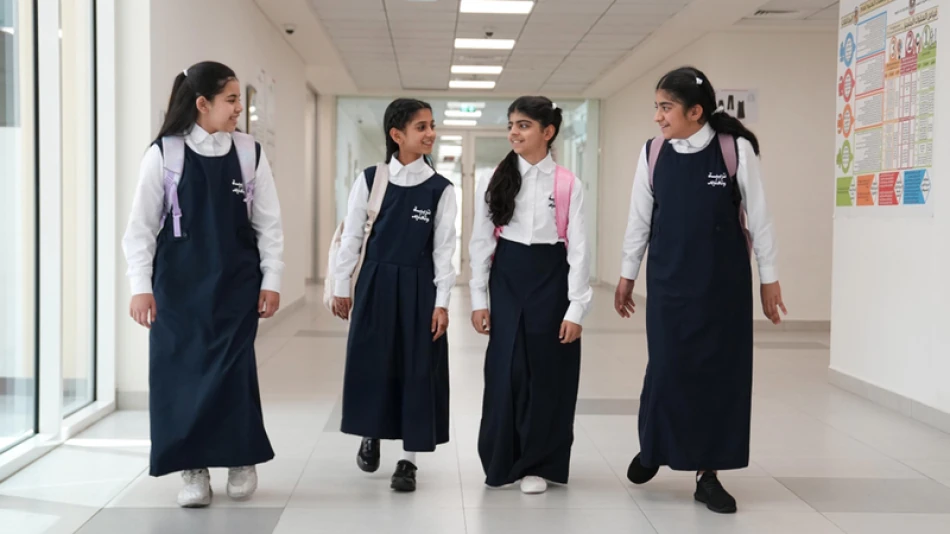
School Uniform Fees Hike Boosts Demand for Tailoring Shops
UAE Parents Turn to Local Tailors as Private School Uniform Costs Soar to $400 Per Student
Rising school uniform prices in UAE private schools are driving parents to seek alternatives at local tailoring shops, where they can cut costs by up to 50%. With some schools charging as much as 1,500 dirhams ($408) per uniform set, families with multiple children are increasingly turning to neighborhood tailors who offer identical designs at half the price, highlighting growing concerns about educational affordability in one of the region's most expensive school markets.
The Financial Burden on Families
The scale of the uniform pricing issue becomes clear when examining individual family expenses. Parents report paying an average of 700 dirhams ($190) per child for school uniforms, with costs reaching 1,500 dirhams for complete sets at international schools. For families with multiple children across different grade levels, these expenses can easily exceed 3,000-4,000 dirhams annually—a significant burden when added to already substantial tuition fees.
Randa Ibrahim, mother of two daughters at an international school, discovered that a single uniform set cost 750 dirhams at her children's school. "I need to buy two sets for each daughter, which means 1,500 dirhams per child," she explained. By switching to a local tailor, she managed to obtain the same quality uniforms at roughly half the cost.
The Tailor Shop Solution
Local tailoring shops have emerged as the primary alternative, offering identical uniform designs at substantially lower prices. Abdul Karim Khan, a sales manager at a tailoring shop, reports that his prices average 40-50% less than school-sold uniforms. Basic t-shirts and shirts cost 30-40 dirhams, while jackets range from 50-60 dirhams—compared to much higher school prices.
The business model works because tailors can source materials directly and operate with lower overhead costs than school uniform suppliers. They've also adapted to meet exact school specifications, ensuring their products match official requirements while maintaining quality standards suitable for daily wear.
Regulatory Response and Market Dynamics
The Sharjah Private Education Authority has attempted to address pricing concerns by mandating that schools charge educational fees—including uniforms—within approved limits. The authority explicitly prohibits schools from collecting unauthorized fees, though enforcement and price transparency remain ongoing challenges.
This regulatory approach reflects broader tensions in the UAE's private education sector, where international schools cater to expatriate families but face criticism for pricing practices that can exclude middle-income households.
Regional Context and Comparisons
The UAE's school uniform pricing issue mirrors similar challenges across the Gulf region, where private international schools dominate the expatriate education landscape. Unlike countries with strong public school systems, the UAE's reliance on private education creates market dynamics where ancillary costs like uniforms can become profit centers rather than educational necessities.
In contrast, countries like Singapore and parts of the United States have implemented stricter controls on school-related expenses, recognizing that excessive costs can undermine educational accessibility—a principle the UAE appears to be gradually adopting through regulatory measures.
Educational Philosophy vs. Commercial Reality
Dr. Saeed Nouri, an education expert, emphasizes that uniform policies should promote equality among students and maintain school discipline, not create additional financial burdens for families. The current pricing structure contradicts these educational objectives by potentially creating economic barriers within supposedly inclusive school environments.
The trend toward alternative uniform sources suggests parents are prioritizing practical solutions over school-mandated purchasing channels. This shift could pressure schools to reconsider their uniform pricing strategies or risk losing control over this revenue stream entirely.
Market Implications and Future Trends
The growing tailor shop market for school uniforms indicates a broader economic adjustment in the UAE's education sector. As families become more cost-conscious and alternative suppliers prove viable, schools may need to justify their uniform pricing or face continued market share erosion to local competitors.
This development also suggests that educational regulators may need to strengthen oversight of ancillary school costs, potentially implementing price caps or requiring greater transparency in uniform pricing to ensure educational accessibility remains aligned with the UAE's broader social and economic objectives.
 Sara Khaled
Sara Khaled







